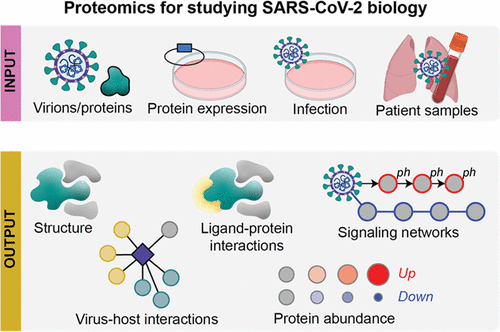当前位置:
X-MOL 学术
›
J. Proteome Res.
›
论文详情
Our official English website, www.x-mol.net, welcomes your feedback! (Note: you will need to create a separate account there.)
Proteomic Approaches to Study SARS-CoV-2 Biology and COVID-19 Pathology
Journal of Proteome Research ( IF 4.4 ) Pub Date : 2021-01-19 , DOI: 10.1021/acs.jproteome.0c00764 Paige Haas 1, 2, 3, 4 , Monita Muralidharan 1, 2, 3, 4 , Nevan J Krogan 1, 2, 3, 4, 5 , Robyn M Kaake 1, 2, 3, 4 , Ruth Hüttenhain 1, 2, 3, 4
Journal of Proteome Research ( IF 4.4 ) Pub Date : 2021-01-19 , DOI: 10.1021/acs.jproteome.0c00764 Paige Haas 1, 2, 3, 4 , Monita Muralidharan 1, 2, 3, 4 , Nevan J Krogan 1, 2, 3, 4, 5 , Robyn M Kaake 1, 2, 3, 4 , Ruth Hüttenhain 1, 2, 3, 4
Affiliation

|
The novel severe acute respiratory syndrome coronavirus 2 (SARS-CoV-2), the causative agent of coronavirus disease 2019 (COVID-19), was declared a pandemic infection in March 2020. As of December 2020, two COVID-19 vaccines have been authorized for emergency use by the U.S. Food and Drug Administration, but there are no effective drugs to treat COVID-19, and pandemic mitigation efforts like physical distancing have had acute social and economic consequences. In this perspective, we discuss how the proteomic research community can leverage technologies and expertise to address the pandemic by investigating four key areas of study in SARS-CoV-2 biology. Specifically, we discuss how (1) mass spectrometry-based structural techniques can overcome limitations and complement traditional structural approaches to inform the dynamic structure of SARS-CoV-2 proteins, complexes, and virions; (2) virus–host protein–protein interaction mapping can identify the cellular machinery required for SARS-CoV-2 replication; (3) global protein abundance and post-translational modification profiling can characterize signaling pathways that are rewired during infection; and (4) proteomic technologies can aid in biomarker identification, diagnostics, and drug development in order to monitor COVID-19 pathology and investigate treatment strategies. Systems-level high-throughput capabilities of proteomic technologies can yield important insights into SARS-CoV-2 biology that are urgently needed during the pandemic, and more broadly, can inform coronavirus virology and host biology.
中文翻译:

研究 SARS-CoV-2 生物学和 COVID-19 病理学的蛋白质组学方法
新型严重急性呼吸综合征冠状病毒 2 (SARS-CoV-2) 是 2019 年冠状病毒病 (COVID-19) 的病原体,于 2020 年 3 月被宣布为大流行感染。截至 2020 年 12 月,已开发出两种 COVID-19 疫苗。美国食品和药物管理局授权紧急使用,但没有有效的药物来治疗 COVID-19,并且保持身体距离等流行病缓解措施已经产生了严重的社会和经济后果。从这个角度来看,我们讨论了蛋白质组学研究界如何通过调查 SARS-CoV-2 生物学的四个关键研究领域来利用技术和专业知识来应对这一流行病。具体来说,我们讨论(1)基于质谱的结构技术如何克服局限性并补充传统结构方法,以了解 SARS-CoV-2 蛋白、复合物和病毒体的动态结构;(2) 病毒-宿主蛋白-蛋白质相互作用图谱可以识别 SARS-CoV-2 复制所需的细胞机制;(3) 整体蛋白质丰度和翻译后修饰分析可以表征感染期间重新连接的信号通路;(4) 蛋白质组技术可以帮助生物标志物识别、诊断和药物开发,以监测 COVID-19 病理学并研究治疗策略。蛋白质组学技术的系统级高通量能力可以对大流行期间迫切需要的 SARS-CoV-2 生物学产生重要见解,更广泛地说,可以为冠状病毒病毒学和宿主生物学提供信息。
更新日期:2021-02-05
中文翻译:

研究 SARS-CoV-2 生物学和 COVID-19 病理学的蛋白质组学方法
新型严重急性呼吸综合征冠状病毒 2 (SARS-CoV-2) 是 2019 年冠状病毒病 (COVID-19) 的病原体,于 2020 年 3 月被宣布为大流行感染。截至 2020 年 12 月,已开发出两种 COVID-19 疫苗。美国食品和药物管理局授权紧急使用,但没有有效的药物来治疗 COVID-19,并且保持身体距离等流行病缓解措施已经产生了严重的社会和经济后果。从这个角度来看,我们讨论了蛋白质组学研究界如何通过调查 SARS-CoV-2 生物学的四个关键研究领域来利用技术和专业知识来应对这一流行病。具体来说,我们讨论(1)基于质谱的结构技术如何克服局限性并补充传统结构方法,以了解 SARS-CoV-2 蛋白、复合物和病毒体的动态结构;(2) 病毒-宿主蛋白-蛋白质相互作用图谱可以识别 SARS-CoV-2 复制所需的细胞机制;(3) 整体蛋白质丰度和翻译后修饰分析可以表征感染期间重新连接的信号通路;(4) 蛋白质组技术可以帮助生物标志物识别、诊断和药物开发,以监测 COVID-19 病理学并研究治疗策略。蛋白质组学技术的系统级高通量能力可以对大流行期间迫切需要的 SARS-CoV-2 生物学产生重要见解,更广泛地说,可以为冠状病毒病毒学和宿主生物学提供信息。



























 京公网安备 11010802027423号
京公网安备 11010802027423号